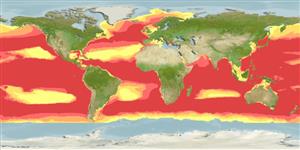>
Aulopiformes (Grinners) >
Alepisauridae (Lancetfishes)
Etymology: Alepisaurus: Greek, alepis, -idos = without scales + Greek, sauros = lizard (Ref. 45335); ferox: The specific name is derived from ferox, meaning ferocious (Ref. 6885).
More on author: Lowe.
Environment: milieu / climate zone / depth range / distribution range
Ökologie
seewasser bathypelagisch; ozeanodrom (Ref. 51887); tiefenbereich 0 - 1830 m (Ref. 50550). Deep-water; 84°N - 57°S, 180°W - 180°E
Circumglobal: Western Pacific (Ref. 6885, 7300); Eastern Pacific: from the Aleutian Islands to Chile, also (Ref. 2850); Western Atlantic: Gulf of Maine to the Gulf of Mexico and the Caribbean Sea, also (Ref. 7251); Eastern Atlantic (Ref. 4059). Indian Ocean (Ref. 57630). Northwest Atlantic: Canada (Ref. 5951). South China Sea and East China Sea (Ref. 74511).
Size / Gewicht / Alter
Maturity: Lm ? range ? - ? cm
Max length : 215 cm TL Männchen/unbestimmt; (Ref. 7251); common length : 150 cm TL Männchen/unbestimmt; (Ref. 5217); max. veröff. Gewicht: 9.0 kg (Ref. 42154)
Rückenflossenstacheln (insgesamt): 0; Rückenflossenweichstrahlen (insgesamt): 30-45; Afterflossenstacheln 0; Afterflossenweichstrahlen: 13 - 18; Wirbelzahl: 47 - 52. Mouth large with two erect fangs on palatines. Dorsal fin very high, about three rays beginning with third or fourth much exerted; adipose moderate in size, over posterior part of anal insertion (Ref. 6885). Generally pale, iridescent, darker dorsally; lateral adipose keel dark; all fins dark brown or black; peritoneum black (Ref. 6885). Branchiostegal rays: 7-8 (Ref. 36025).
Mainly inhabit tropical and subtropical waters; however, during the feeding period adults may migrate to the subarctic reaching as far north as Greenland, Iceland and the Bering Sea (Ref. 51887). Epipelagic- and mesopelagic, from near the surface to below 1,000 m, sometimes approaching inshore waters (Ref. 6011). Bathypelagic (Ref. 58302). Mainly nocturnal. Feeds on fishes, cephalopods, tunicates, and crustaceans (Ref. 6011). Preyed upon by opah, sharks, albacore, yellowfin tuna, and fur seals (Ref. 6885). Oviparous, with planktonic larvae (Ref. 36025). Are synchronous hermaphrodites (Ref. 84733). Occasionally consumed but of little importance due to its soft flesh (Ref. 5217). The maximum weight given is for a 167 cm FL specimen (Ref. 42154).
Life cycle and mating behavior
Geschlechtsreife | Fortpflanzung | Ablaichen | Eier | Fecundity | Larven
Oviparous. Gonads of adolescents are hermaphroditic, but there is no proof that the species is a functional hermaphrodite (Ref. 6011). However, further studies show that this species is a synchronous hermaphrodite where gonads consist of clearly defined and well separated ovarian and testicular regions with no indication of sequential maturation of the sex products (Ref. 84733).
Post, A., 1984. Alepisauridae. p. 494-495. In P.J.P. Whitehead, M.-L. Bauchot, J.-C. Hureau, J. Nielsen and E. Tortonese (eds.) Fishes of the north-eastern Atlantic and the Mediterranean. UNESCO, Paris. Vol. 1. (Ref. 6011)
IUCN Rote Liste Status (Ref. 130435)
Bedrohung für Menschen
Harmless
Nutzung durch Menschen
Mehr Information
ReferenzenAquakulturAquakultur ProfilZuchtlinienGenetikElectrophoresesVererbbarkeitKrankheitenVerarbeitungNutrientsMass conversion
Tools
Zusatzinformationen
Download XML
Internet Quellen
Estimates based on models
Preferred temperature (Ref.
123201): 4.7 - 14.6, mean 8.9 °C (based on 1772 cells).
Phylogenetic diversity index (Ref.
82804): PD
50 = 1.0000 [Uniqueness, from 0.5 = low to 2.0 = high].
Bayesian length-weight: a=0.00389 (0.00180 - 0.00842), b=3.12 (2.94 - 3.30), in cm total length, based on all LWR estimates for this body shape (Ref.
93245).
Trophic level (Ref.
69278): 4.0 ±0.2 se; based on diet studies.
Fishing Vulnerability (Ref.
59153): Very high vulnerability (90 of 100).
Nutrients (Ref.
124155): Calcium = 13 [4, 37] mg/100g; Iron = 0.292 [0.097, 0.916] mg/100g; Protein = 16.3 [13.1, 18.8] %; Omega3 = 0.0817 [, ] g/100g; Selenium = 33.6 [10.2, 94.9] μg/100g; VitaminA = 7.96 [0.91, 66.44] μg/100g; Zinc = 0.284 [0.147, 0.569] mg/100g (wet weight);
